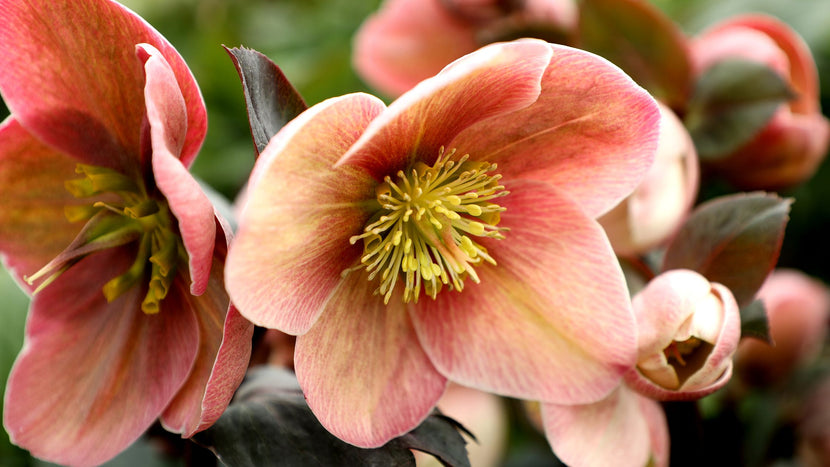
Perennials That Add Winter Interest To The Landscape
Creating seasonal interest in the landscape that covers all four seasons is the basis for the four-season garden. Previously we've covered using trees, shrubs, and ornamental grasses for winter interest in the winter landscape.
In this installment, were going to be discussing the use of perennial plants for winter interest!When most gardeners think of perennials, they think of colorful summer blooms and the exciting color and texture of the leaves and flowers.
While it's true that many perennials go dormant and die back to the ground in the winter, many perennials have a presence in the garden well into winter, even when dormant. This presence can be the stout and sturdy like the Black-Eyed Susans seed heads or the Astilbe's plume-shaped seed heads.
I mentioned the seed heads of Rudbeckia Goldstrum. Many colorful birds are drawn to those seeds as a source of food, and the filtering colors created by dancing songbirds on a gray winter day can be a joy to watch. Colorful birds such as cardinals, blue jays, and American goldfinch can often be seen dancing in the winter garden.
Remember that winter interest is in the eyes of the beholder, and plants are only part of the story.
Perennial Placement That Makes An Impact

Before discussing our favorite perennial plants that provide winter interest, we should discuss how to properly arrange perennials to get the most out of them! Because perennials are typically the smallest plants in the landscape, they sometimes need help to be seen in the winter garden. This can be accomplished in several ways.
First, just like we mentioned in our Deciduous Shrubs for Winter Interest blog, perennials can also be planted in front of evergreens to act as a backdrop and enhance the colors and textures of plants.
Secondly, Perennials can be planted at the base of a hill or bank in the landscape. This causes the plants to stand out after freshly fallen snow.
The easiest way to bring perennials to the forefront of the winter landscape is to do just that, bring the perennials to the forefront. Hellebores are perfect for this due to their exciting leaf patterns and winter flowers. Due to their small size, perennials can be planted along pathways or other decorative furnishings in the garden, such as benches, birdbaths, and ponds.
The Best Perennials for Winter Interest

Hellebore: This plant should be at the top of any gardener's list of perennials for winter color. Few perennials flower in the winter, and of the ones that do, hellebores are the royalty of this group. For many years hellebores seemed out of reach to the average gardener, but recent advances in breeding techniques have brought this excellent plant within reach of any gardener.
The heavily mottled green leaves and deep rich flowers blend well with red twigged dogwoods or evergreen shrubs such as globe blue spruce, and they even blend well with the bright red berries of blue hollies.

Heucheras: Heucheras bring a wide range of colors to the landscape with their colorful leaves. In the winter, heucheras create interest as the leaves take on darker, richer colors. Although the leaves can get battered during the winter, in early spring, just cut the leaves back to the crown, and a new flush of leaves will follow as the weather warms.

Sedums: The sedum family is a very diverse family of plants, and the way they create winter interest is no less varied. Upright sedums tend to lose their leaves in the winter, but the sturdy seed heads remain upright even after a snowfall. This creates the effect of small floating clouds of snow, and the birds enjoy picking the small seeds from the seed heads.
The lower groundcover sedums are mostly evergreen and remain colorful throughout the winter, creating mats of red, yellow, and green colors throughout the garden.
One of our favorite ways to use groundcover sedums, such as the Dragons Blood Sedum, is to plant it on the tops of stone walls and allow it to trail over and hang in front of the stones. The deep red color looks fantastic in front of lighter stones.

Rudbeckia & Echinacea: These plants are closely related and create winter interest, not with foliage or bright, colorful flowers in winter but rather with the remains of those bright-colored flowers.
Rudbeckia and Echinacea flower stalks look interesting in the snow and attract many colorful winter birds to the garden. Interplant these with ornamental grasses such as Calamagrostis acutiflora 'Karl Foerster' or panicum to create a proper habitat for colorful birds.
Shop Winter Interest Perennials At Garden Goods Direct
These are just a few perennials that create winter interest, and we're confident once you embrace the idea that winter interest can come from more than flowers. Interest can come from textures, movement, visiting wildlife, and just about any way you can imagine. Interest is in the eye of the beholder.
Embrace the concept of the four-season garden, and it will embrace you back with endless seasons of beauty. Gone are the days of drab winter gardens. Visualize the colors and textures that make winter one of the most brilliant seasons in the garden. Plan now for many enjoyable seasons to come.
Until next time, see you in the garden.
-Woodie
